This must be one of the most unpredictable La Liga seasons in many years. Real Madrid and Barcelona no longer dominate the Spanish top-tier, but teams such as Sevilla and Atlético Madrid have been impressive. However, after the first 10 games, the league leader was Real Sociedad, a team that has not won any major trophy since 1987.
So, it is an extremely intriguing topic to analyze the factors that contributed to Sociedad’s impressive run so far. More importantly, head coach since 2018 – Imanol Alguacil who transformed Erreala is the key. Maybe he is not as well-known as the likes of Luis Enrique and Unai Emery outside of Spain, but his philosophy of play demonstrates the basics of football.
This tactical analysis piece, instead of focusing on individuals in the Basque Country, will cover some open play principles of Alguacil. After retiring at Burgos CF, he worked at the Sociedad academy and B team for eight years. Current key players in the squad – the likes of Mikel Oyarzabal and Robin Le Normand were developed by the 49-year-old head coach.
Alguacil has favoured a 4-1-4-1 formation on paper, but these are just like numbers in telephone books. In the game, his team could play in a 4-2-2-2, 4-3-3, 4-2-3-1, 3-4-1-2, 3-1-4-2, 2-1-4-3, 2-2-4-2 and even more formations. The most important bit is to find the right solution when facing different problems.
Positioning and structural principles
Alguacil’s football is extremely attacking in nature, as his team likes to keep the ball and dominate the game and their opponents. Before dissecting the ways of progression, the prerequisite is to understand the principles of the player’s movement and positioning. To facilitate fluid positional plays, players need reference points to know where and when to appear, optimizing the attack in a collective manner.
In terms of the build-up shape, there are many variations and tactics adopted by Alguacil’s team. The two most common patterns are the 3-2 or 4-1-2 that are shown in these images. However, regardless of the shape, there are some key principles that generate space in the attack. In-possession, they are trying to make the pitch as big as possible by maintaining three elements – height, width, and depth. In other words, to stretch the opposition vertically and horizontally. Against man-oriented teams, this would open horizontal gaps for vertical build-up, while teams staying in position would offer more space for the build-up players.
Alguacil also wants his team to maintain multiple offensive layers in the attack. The layers should exist by using the opponents’ positions as reference points to manipulate defensive lines. It means the supportive players should always stay behind the opposition lines, ideally on the blindsides of the defence. This either constrain the opposition’s behaviour to pressure the backline or instantly exploits space left behind the pressing players.

Another principle is the manipulation of the opponents to generate space and options. Even players without the ball should always work hard to serve the collective good. Decoy movements, rotational movements or just simple positioning shall pin the opponents as they wish.
Also, players should be supporting the man on the ball always, but not by moving towards the ball, as this invites pressure and compresses spaces. Instead, they should move in front of the ball to provide multiple progressive passing options.
This coming example is a summary of the above concepts. Firstly, the Sociedad midfield three positioned themselves behind the opposition’s midfield. The advanced midfielders in particular, were behind the second line, staying between the players, which occupied the four opponents, despite Sociedad being numerically disadvantaged with just two players in that zone. In Granada’s 4-4-1-1 defensive system, the midfielders were dragged apart, opening a vertical passing lane to the striker.
When Oyarzabal was playing as the left-winger, he enjoyed the freedom to roam from his position. One popular movement was the one in the example – by diagonally dropping into the half-spaces, which put the right-back under pressure. He is then forced to track Oyarzabal into central areas, leaving the wide space open for the Sociedad left-back.
These are just options near the ball. The centre-backs had more choices than these two, as they could also play the ball to the weak side, where the right-winger and right-back are totally free.
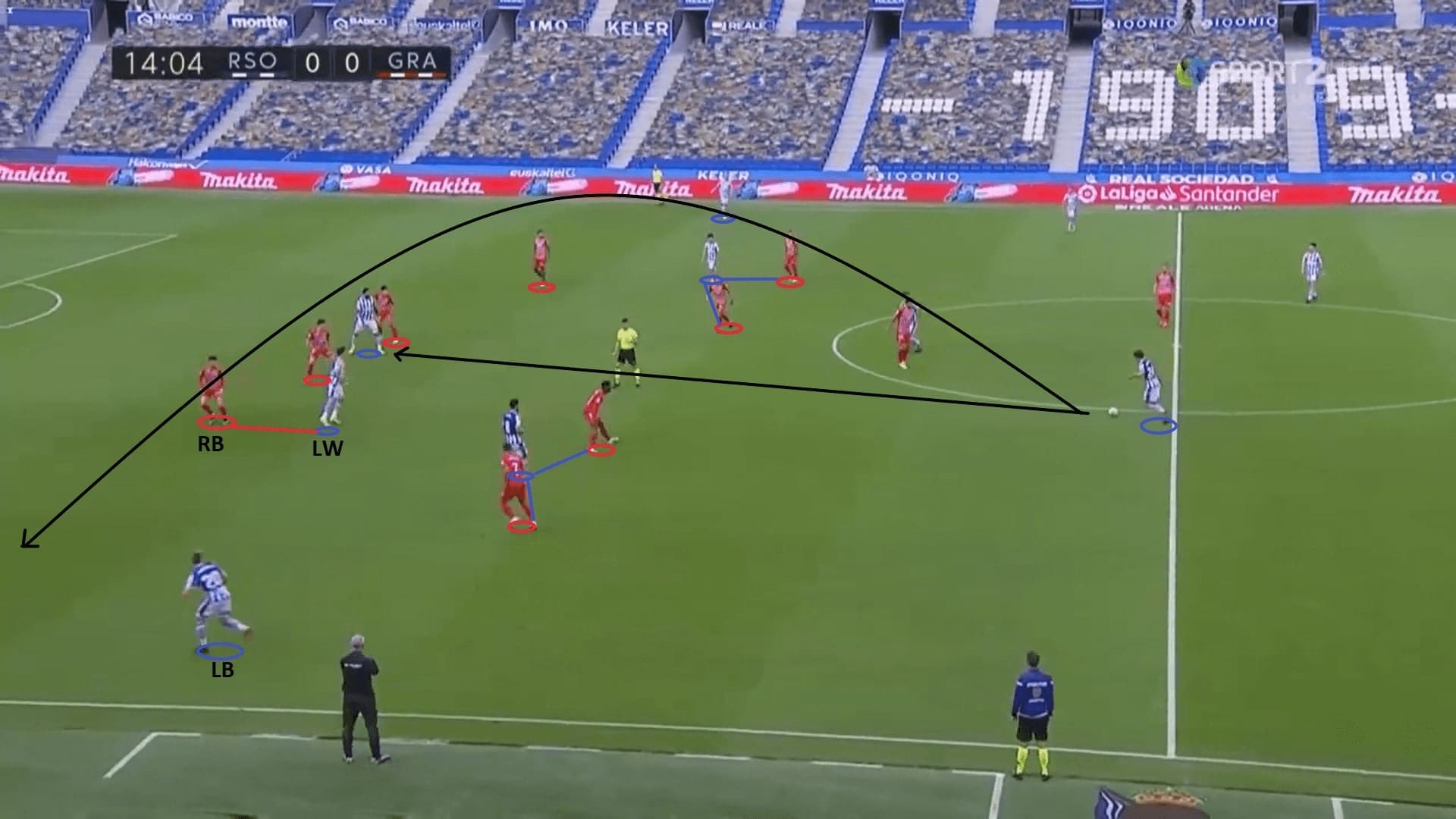
Combining the above principles, the front three could always collaborate with the full-backs to attack the backline. Alguacil always expects his wingers and the striker to provide offensive height, while they should manipulate the horizontal compactness of the defence, trying to stretch the back four or open horizontal gaps to run into.
The positioning of the wingers should depend on the situation. If the full-backs were yet to provide the offensive width in advanced areas, the wingers occupy the wide zones. If the full-backs were up there, they could tuck into the half-spaces, but there are variations to this theme. One winger should stay in the inside channel, while the other one should stay at the outside of the back four. This offers dynamism in the offensive third. For the outside winger, he could combine with the full-back or release him into zone 16 or zone 18.
On most occasions, the quickest player is the inside winger, who was asked to provide the offensive height. At Sociedad, that role belongs to Portu, the right-winger. The striker could slightly drop off from the opposition backline, not only opening a passing lane for the ball, but also creating a decisional crisis for the centre-back. The marker can either let the striker unmarked, or as shown in this tactic board, step up. Then, the winger could run diagonally into those spaces after positioning himself in the horizontal channel early.
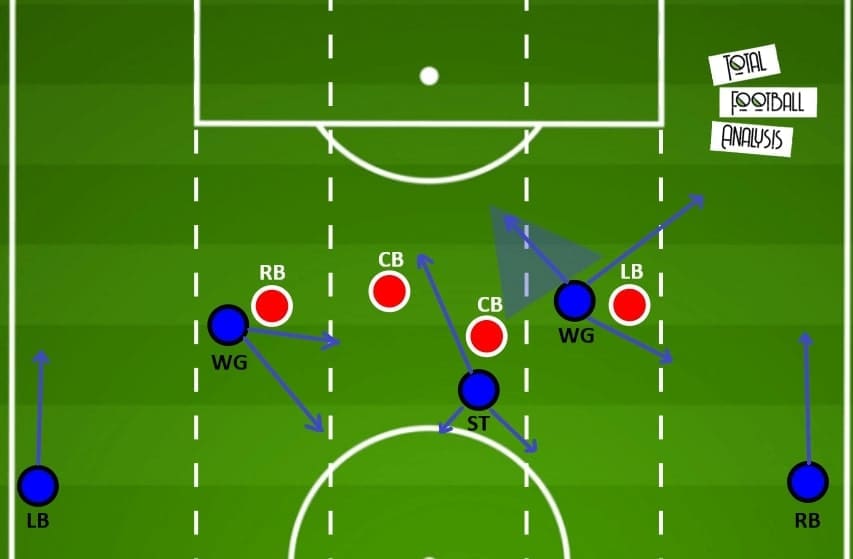
Central overload, ball progression, verticality
Layers, height, depth, width, manipulations, these are the principles of play for Alguacil’s team. Under these concepts, the players effectively position themselves to generate space to construct offensive plays. Therefore, ball progressions are easier.
In the build-up, if the team only had one player in the first line, then, Sociedad should break this line by at most three players. The pivot should stay in front of the centre-backs, creating a 2-1 triangular shape to occupy the striker. In this game, Napoli played with a 4-2-3-1, so Ander Guevara should not stay too deep to invite pressure to the backline. Another benefit of the positioning was the angles created to exchange passes with both centre-backs.
This example also perfectly demonstrated the idea of layers in Alguacil’s game model. The three midfielders staggered at three horizontal zones, between two Napoli defensive lines. These are the manipulation of the defenders’ behaviours. Meanwhile, the central overload also opened the wide zone for the right-back. Under these circumstances, a diagonal pass is encouraged to reach the wide runners, as this easily bypassed two defensive lines.
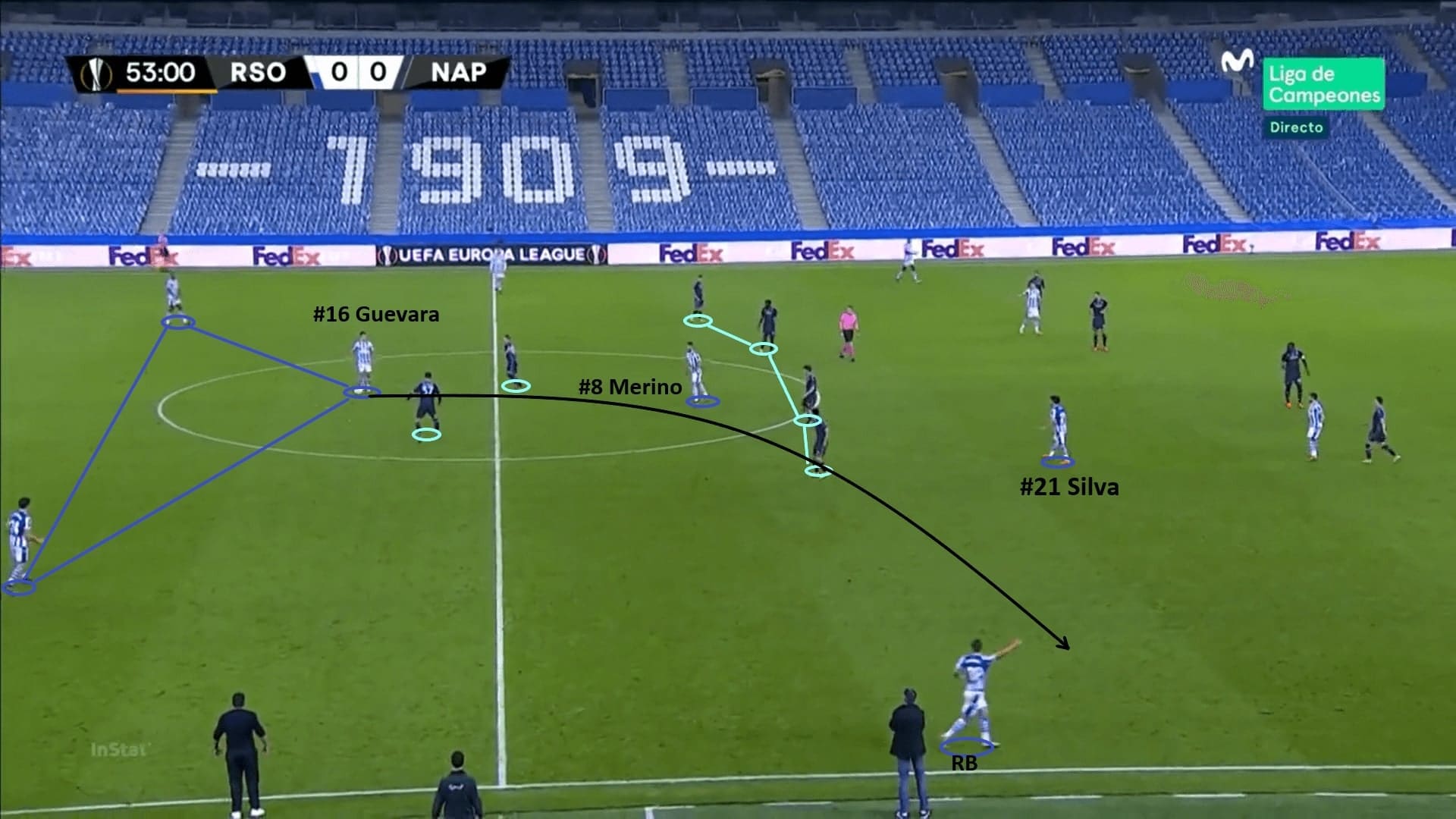
Verticality (or vertical build-up) is an important component of Alguacil’s team. This is an aggressive style that advances the ball quickly while avoiding lateral passes. However, passing vertically would also lead to closed body and opposition pressure, receivers might not be able to perceive sufficient visual information.
Therefore, the passes are seldom purely vertical, but preferably being slightly diagonalized in the same vertical zone. This would create a better angle for the receiver for the next move. Of course, the likes of third-man plays are also commonly used. To avoid losing the ball because of tightened spaces, positionings of players would be vital. Here, echoing the “layers” mentioned above, David Silva perfectly stayed behind to tear the Napoli midfielders apart. This allows Mikel Merino to take a no-touch turn, entering spaces within the midfielders.
Given the crowded central areas, his team also likes to use inside-out pattern when access to zone 14 is blocked or impossible. After receiving the pass from Mikel Merino, Silva quickly released the right-back, who joined the attack in the wide zone. Sociedad could create crossing opportunities in this type of attack.
Every player has their role, even those who are seemingly uninvolved in the progression. In this image, two players were providing the offensive heights, thus, manipulate the positioning of the backline. This enabled Silva to exploit spaces behind the midfield without the pressure from defenders.
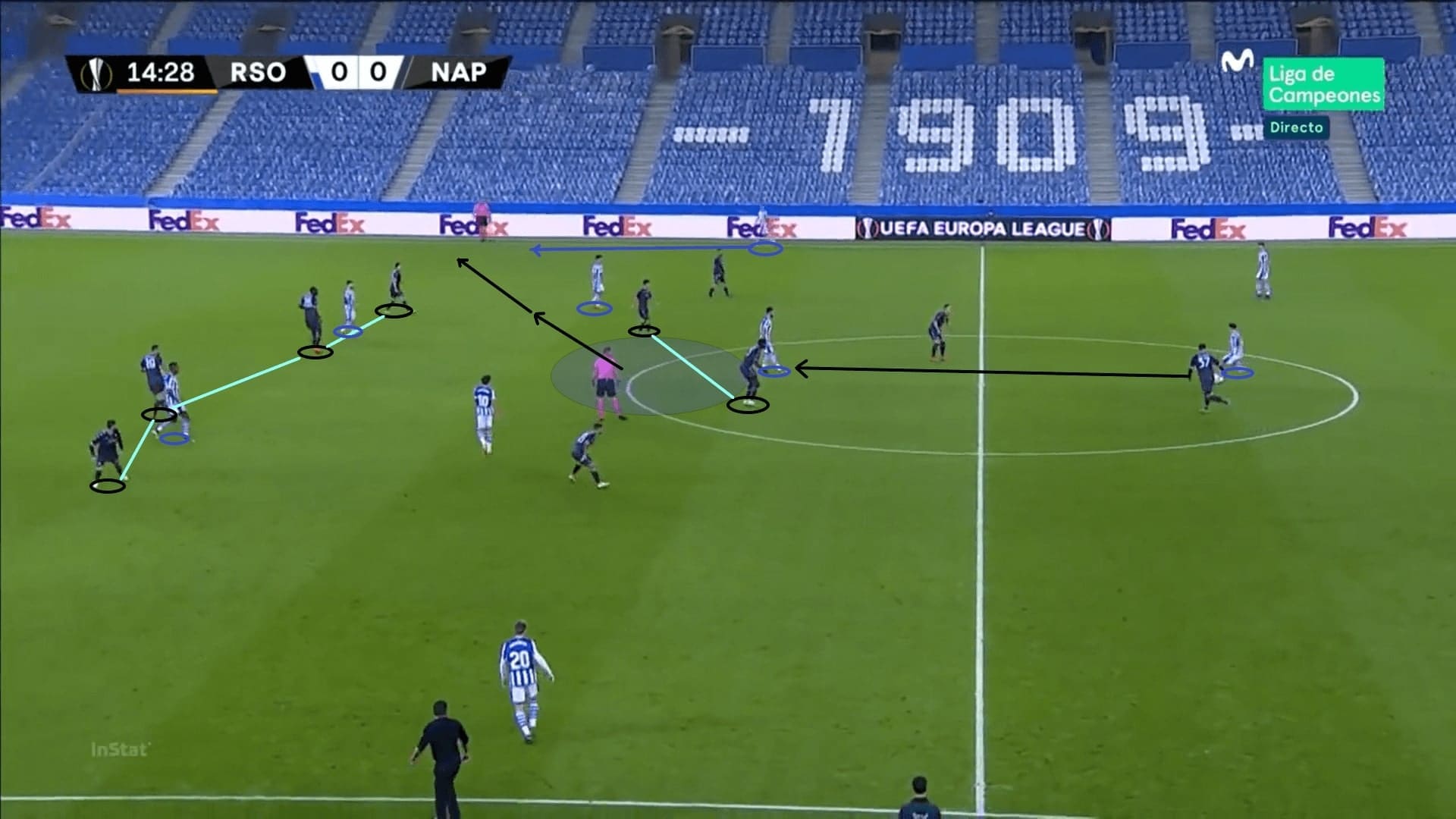
Under pressure at flanks, instead of kicking long balls forward aimlessly, Alguacil still wants his team to play out from the back through combinations. The principle in this phase is to provide multiple options for the ball and the activeness of the full-back.
When the ball reaches the full-back, the ball-near midfielder should always move to the vertical front of the ball – the wide zone. It was vital as the supportive player shall move away from the cover shadow of the pressing player. Most teams intended to block central access, so the shadow work would leave wide spaces free. Timing this movement well could utilize the blindside of the defender too.
Against a man-oriented team, this move could also open spaces that create the dynamics. Usually, the winger approaches the full-back, so it falls to the midfielder to cover the midfielder (Merino in this case). The wide movements could reduce a man at the midfield, opening spaces at the centre. In this example, the left-back had two options to pass. Also, he could also run into the spaces highlighted if the advanced midfielder returns the ball, which was more likely to be the habit of right-footed players.
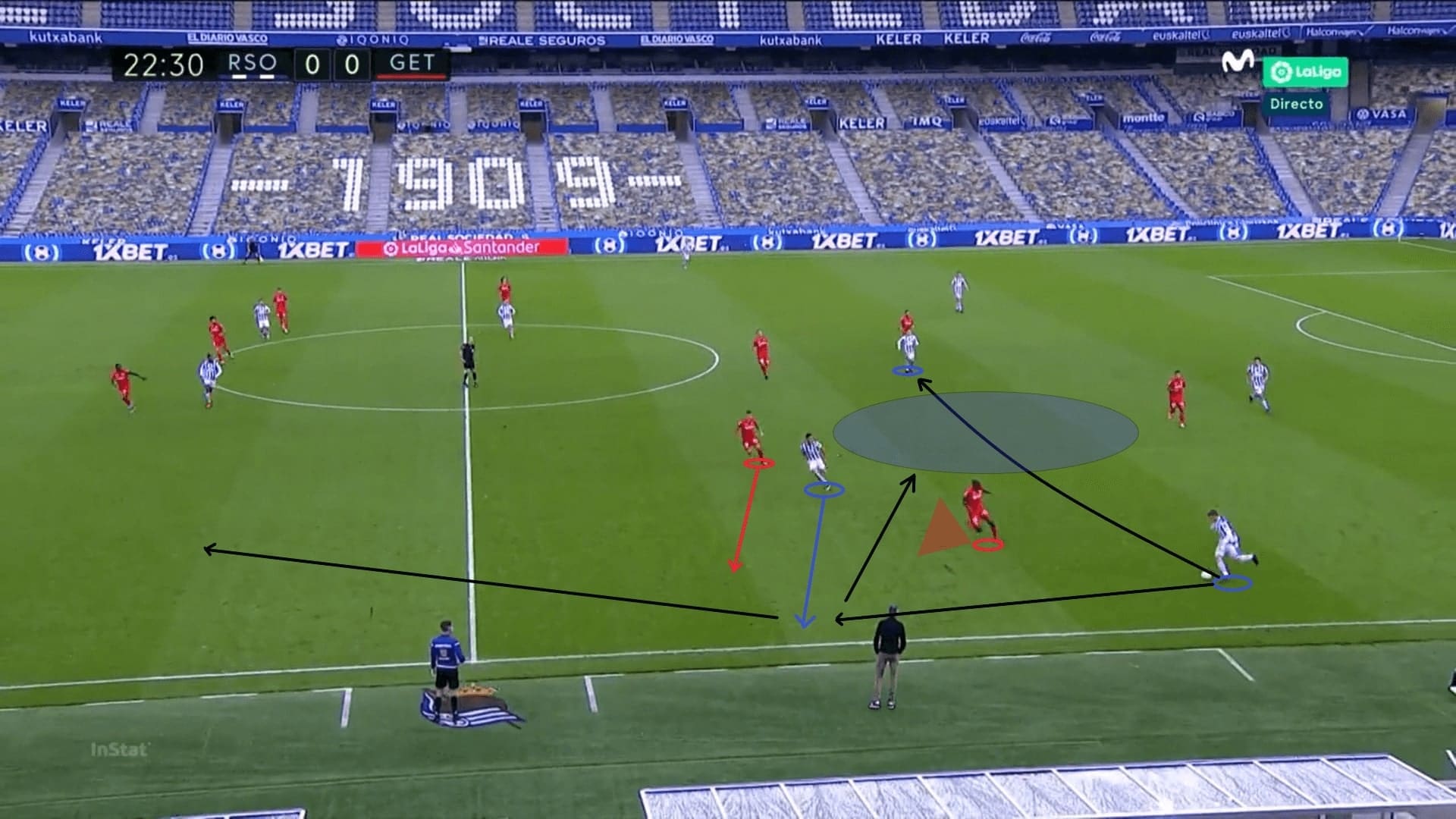
The goalkeeper is always a part of the build-up. This season, Álex Remiro gained his spot in the team, and he was the third-best keeper in the league by passing accuracy (90.28%). Apart from facilitating ball circulation with the defenders, the keeper should be able to play long or vertical passes as well. This is a useful strategy against teams pressing high as spaces must be left behind.
The long balls should be played intentionally, depending on where the free players or free spaces are. Against a man-oriented team such as Madrid, the defensive shape was loose because of the wide positionings of full-backs. Therefore, vertical passing lanes are opened to pass between the defenders, the keeper should utilize that momentum. In this case, Remiro played vertically that bypassed six to seven players.
In other cases which teams are defending narrowly and stayed in shape, spaces would appear at flanks. Then, the task of the keeper is to find the full-backs out wide – all depends on the contexts.
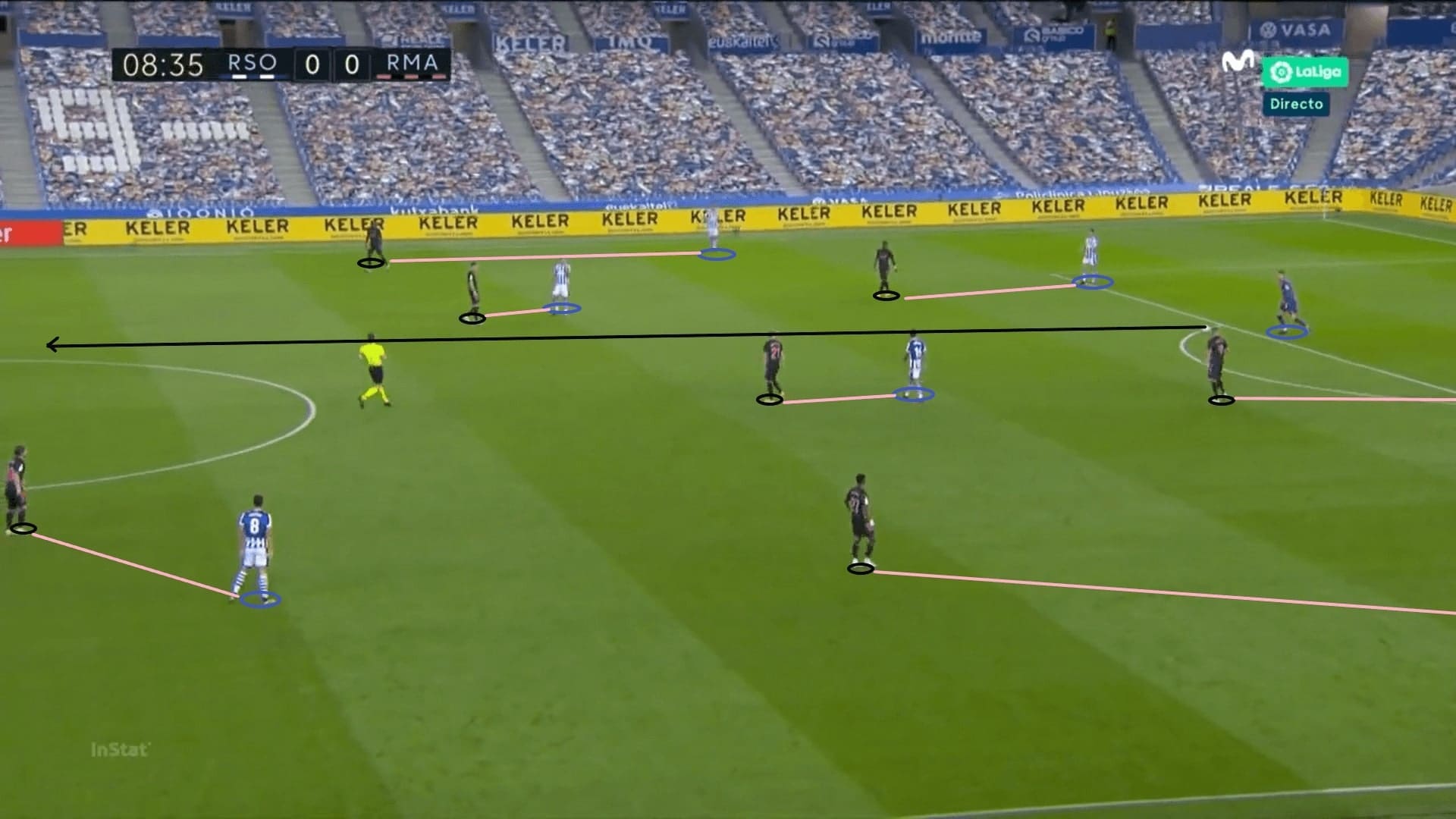
The tasks of the goalkeeper are already suggesting Alguacil’s men are more than a slow build-up team. Instead, the head coach is never against the idea to play long and directly given the right momentum occurred.
This situation is a classic variation of playing out from the back in a 3 v 2. Getafe had two players in the first line, so in this case, the pivot dropped to form a back three, so the backline always had one free player. Now, the wide centre-backs should be capable of bringing the ball forward, having the courage to play long passes.
In the first section, the positionings of the front three were illustrated. This game-situation shows the variations of the attacks. Portu, the quickest winger in the team, of course, provided the offensive height. The striker was always benefitted, hence, could begin his run from deeper positioning to get off his marker. If the delivery was good enough, Sociedad would have 1 v 1 opportunities against the keeper.
The dynamism of the move can include the use of reversed movements as well to support the ball. Here, Silva has moved to the opposite direction as Portu did, including the right-back, the centre-back had three options.
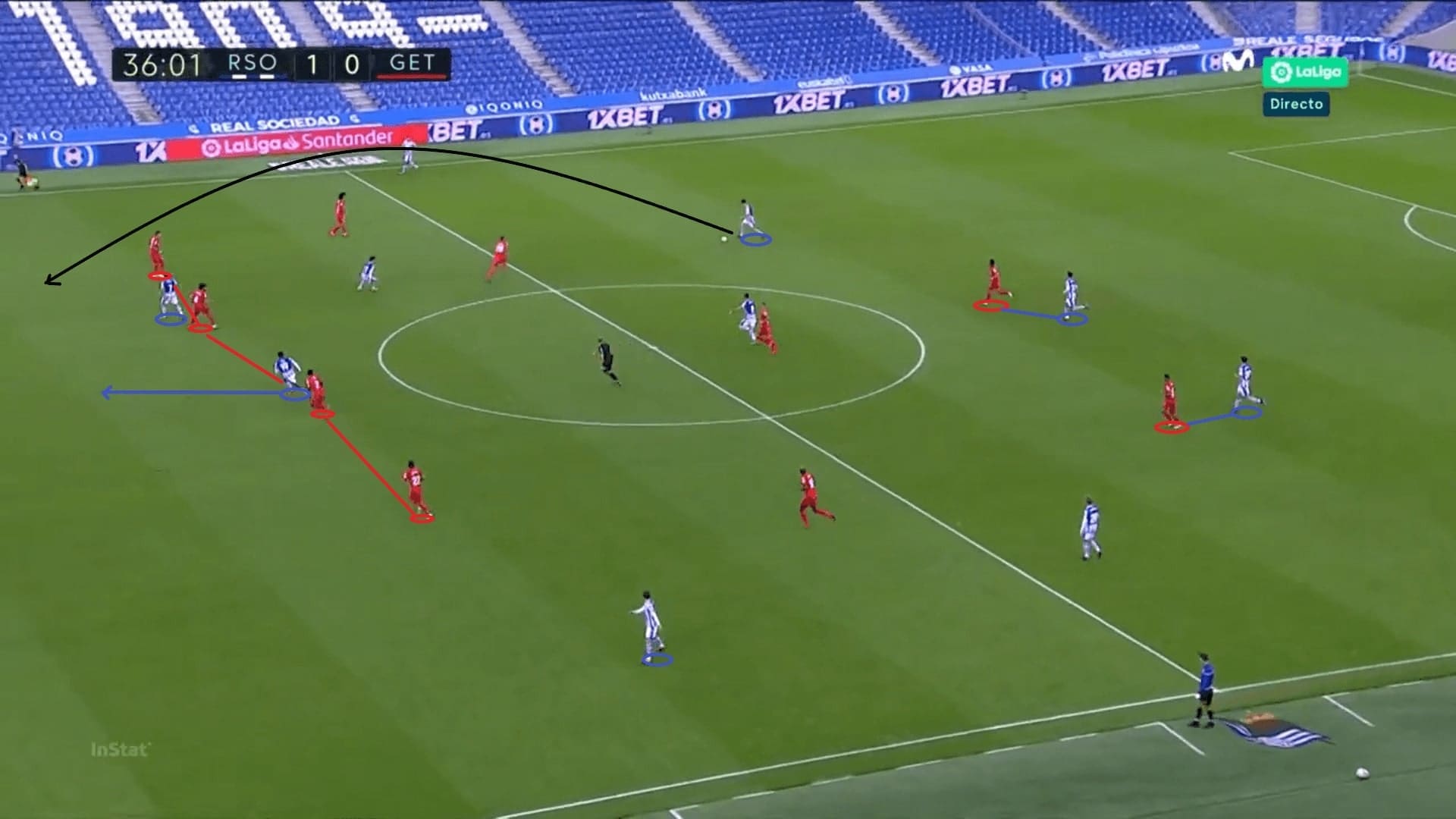
Final passes and variations in the offensive third
In the offensive third, there are a few combinations used by Alguacil’s man. The creative playmakers, such as Martin Ødegaard and Silva could feed through balls and lofted balls to the forward runners. Also, given the wingers are good at finishing and shooting, they operated narrowly at the centre to support each other controlling the compactness of the defence.
In this example, Sociedad front players formed a boxed-shape at the centre, the key was to stay closely at the penalty box. The tight distancing improves interconnectedness, allowing the attacking players to play quick combinations as multiple options.
Here, even if the receiver closed his body initially, he could either leave the ball to the player at height or play to the third-man.
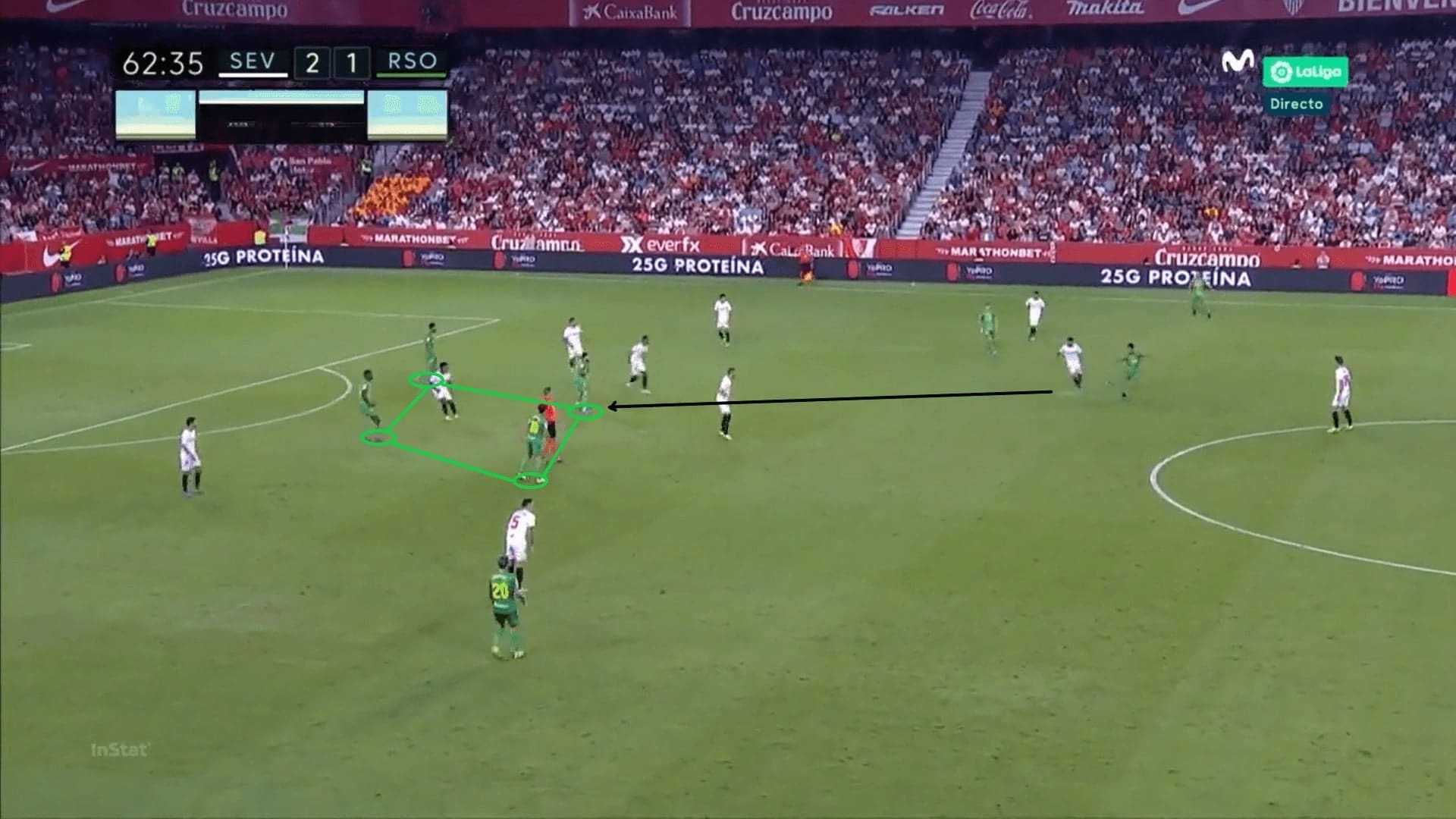
The following examples are some other commonly used movements and patterns of Alguacil’s men in the offensive third. This one is using the winger’s narrow positioning to open spaces for the full-back. Usually, the inward movement or initially narrowed positioning of the winger could attract the marker into the same zone, leaving the wide zones open.
Here, Silva passed centrally. At the same moment, the right-winger made an inward movement that not only offered an option for the ball, but also took the left-back to the centre. It was also a signal for the right-back to attack those opened spaces created, then he could cross.
The former Manchester City man also demonstrated the quality and mentality required – attack the goal always. The key principles of Alguacil in attacking the box are to be explained in the coming section.
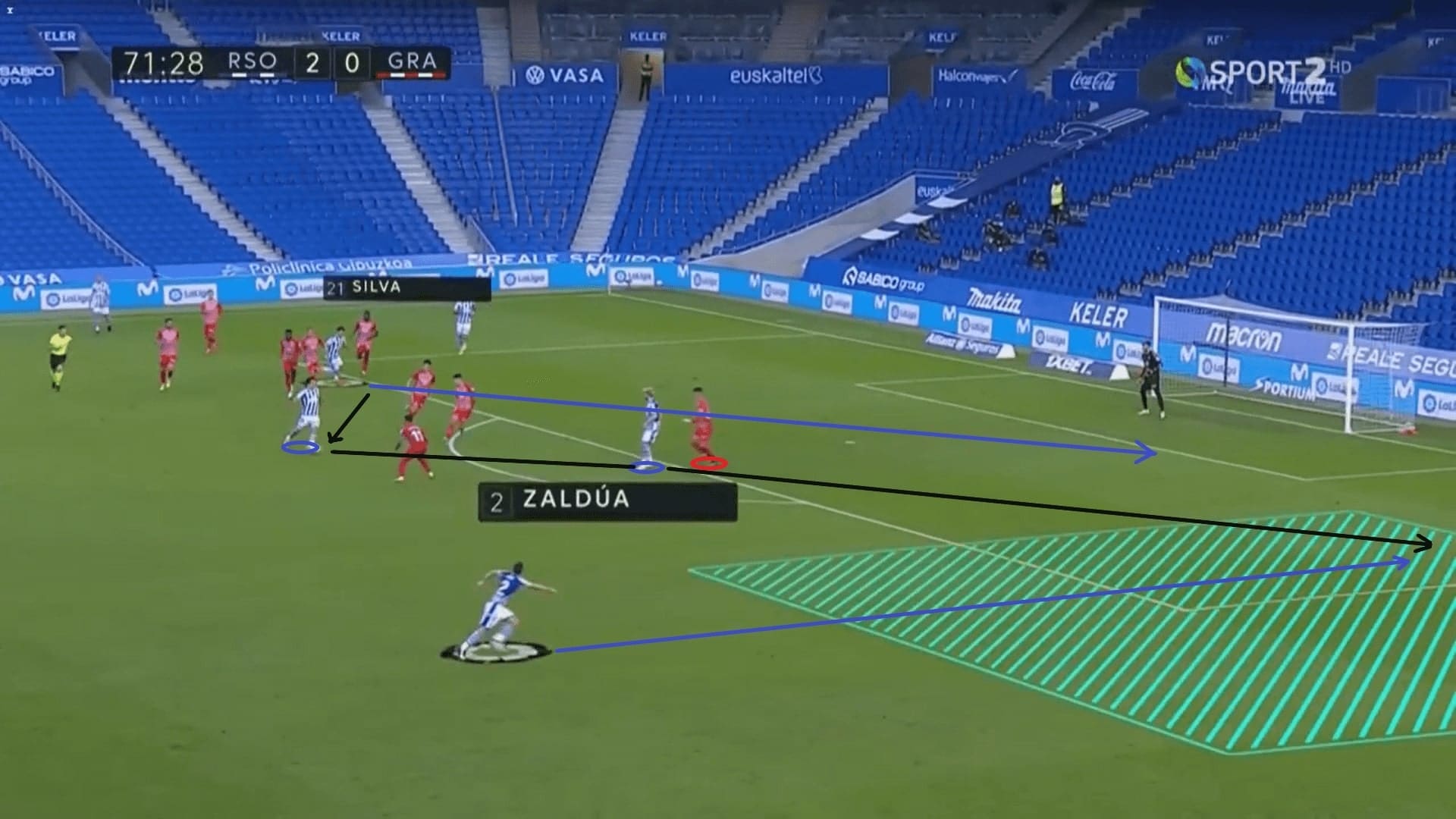
Another concept demonstrated in the Granada example is hitting the underloaded flanks, this is a “play left to go right”. By committing numbers at one flank, the opposition defence often adjusted to the same vertical half. As a result, spaces were available on the weaker side, where the full-back was waiting for a release pass. Ideally, the release pass should be diagonally travelling into spaces, ensuring the receiver gets it without slowing down.
On the ball-side, the supportive movements at the half-spaces would be vital if the crossing angle was narrowed by a marker initially. Algaucil’s players were already ready to run into half-spaces, which was also a form of attacking the depth.
Here, the angle for the right-back to cross was denied by the defender. However, Silva was clever enough to support at zone 17.5, then looking for a cut-back or playing into the six-yard box.
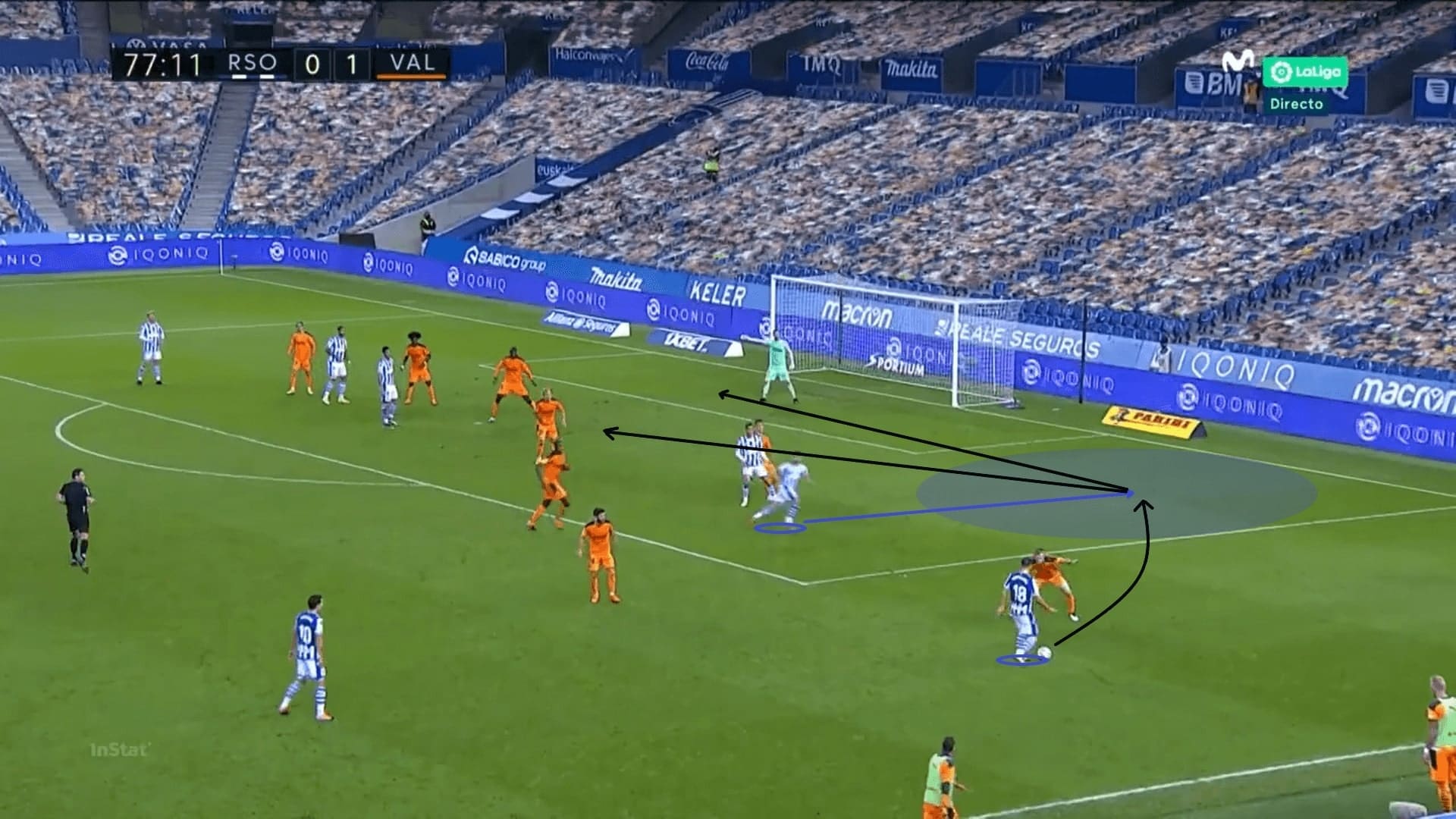
Since crossing is a main source of Sociedad’s attack, the way to attack the penalty box is a key to unlock the defence. It was fascinating to see around three to four players dashing into the penalty box at the same time. Instead of standing statically, they must look for attacking depth, even deep into the six-yard box as this was a favoured target of the cross. With this habit, the defence is expected to retreat deeper, opening spaces at the penalty spot or zone 14 for the late movements.
Contexts change a lot, but a key principle remains the same – it was the attack on the last defender. Usually, the players staying in the penalty box early already reached numerical equality with the back four. What the defence could not defend was the dynamic late movement from the farthest player. Even this could be a left-back, like Monreal in this scenario, the last defender could not defend the blindside. Also, there was more time to read and attack spaces by this player.
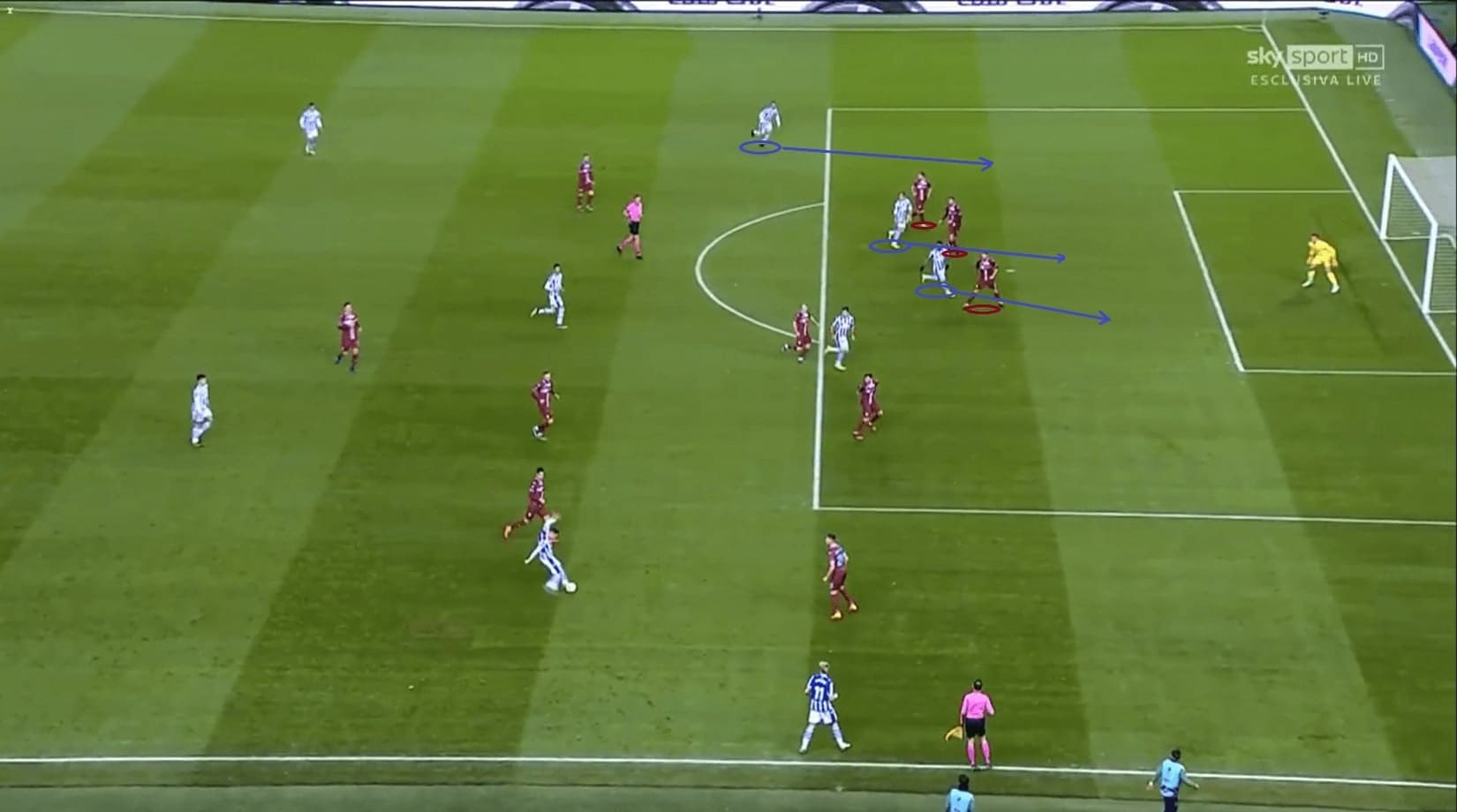
High pressing, the triggers and traps, low block
When out of possession, Sociedad were also an aggressive team that placed a high block near the opposition third. The PPDAs of Sociedad in the latest seasons are 9.27 and 8.25 have suggested their high pressing intensity, ranked fifth and fourth of the league. Initially, Alguacil wants his player to maintain a central overload, then waiting for the signals to press. The tactic board gives us a clearer picture of the system.
In general, the pressing is in a 4-4-2 shape, often initiated by the striker to attack either centre-back. Only after the pass was made, the second player should jump onto the other centre-back to press. Unless there are specific instructions, or else the player is not required to curve his run to shadow the wide zone. Instead, Alguacil wants his team to defend with high intensity, just as he does in every training session. Curving the runs and worrying about the passing lanes would slow the defensive actions, what Alguacil expects is to sprint in full-speed, though attacking the ball was not mandatory. They would just leave the wide zones for the full-backs.
In a midfield trio, the advanced midfielders should push higher to provide the defensive cover for the first line. In the respective zone, they man-marked the opposition second layer of build-up, the tightness would depend on the opponents. For example, against AZ Alkmaar, the markings were extremely tight, but they were looser in the league games. The pivot shall provide another layer of defensive cover for the advanced midfielders, defending spaces or picking any free player. Meanwhile, the far-side winger should always tuck inside to maintain compactness at the midfield.
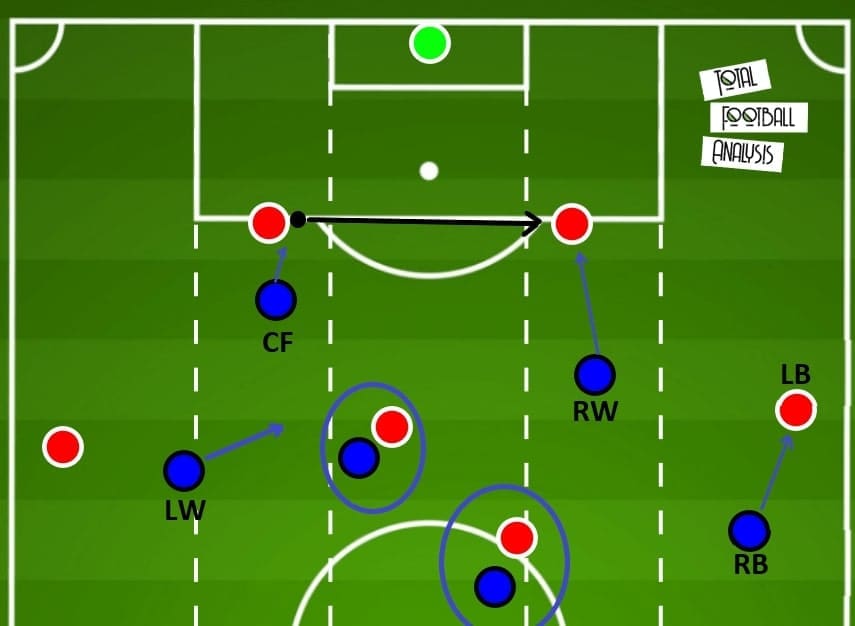
Against opponents playing out from the back with a back three shape, or using goalkeepers in the build-up, there are several adaptations. Firstly, if the keeper was not good at long-passing, Alguacil would like to leave him free and see whether the ball is moved to a centre-back. Then, the striker could press. On other occasions, the pivot dropped early at the backline, more shadowing efforts from the pressing player are required to force the ball into either vertical half. After that, the rest of the team knows where to defend.
This example shows an excellent in-game situation about the press. Against Barcelona, the players were doing their jobs as described in the above analysis. Notice how the right-winger was pressing the centre-back – it was a vertical sprint instead of a curve run. Even the left-back was an option, it was not a problem at all.
Instead, this was the moment which Alguacil wanted his men to win the ball back. The closed body of the opposition left-back was always an invitation to press. Whenever this situation happens, Alguacil’s right-back should commit himself and attack the target without any hesitation.
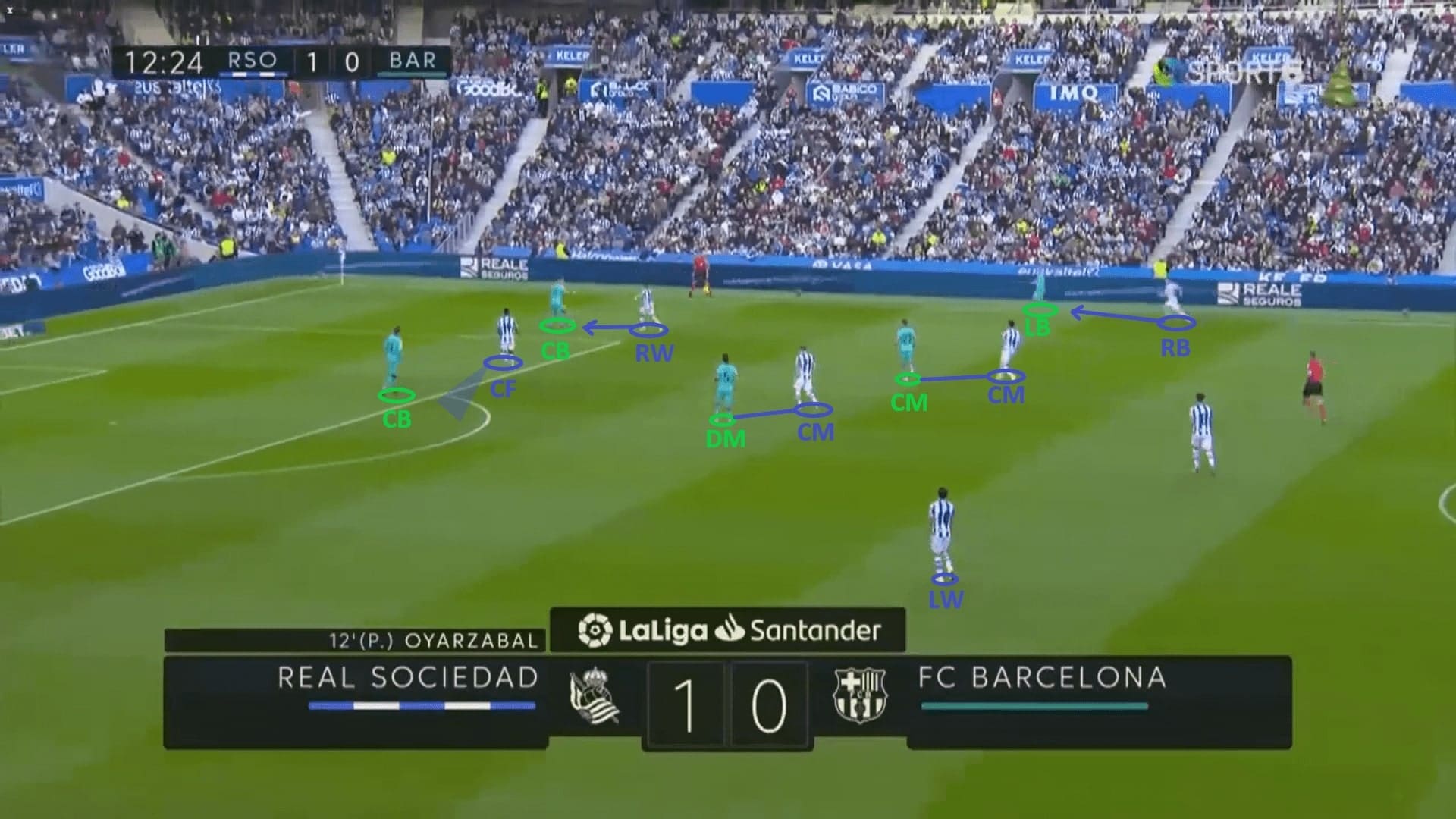
The timing of the press is vital as well, which helps the team to set pressing traps and potentially regain the ball high. Even the tactics are tweaked based on the features of the opponents, the concepts remain unchanged.
Here, the first line was formed by the attacking midfielder with the striker instead of the winger, that was Ødegaard. The loanee from Madrid pressured the centre-back, but the right-winger at the second layer did not synchronize the press to the left-back. This was a pressing trap!
This was because Sociedad were inviting the left-back to receive the ball, who was trapped at the touchline with a closed body. Only after the pass was made by the centre-back, the right-winger would jump onto the target and attack him. Eventually, the 1 v 1 duel was won by Adnan Januzaj and Sociedad scored in the counter-attack.
However, if Januzaj synchronized the press, he would not be able to shadow the opposition at the half-spaces. As a result, the centre-back would not pass to the left-back. Not only would the trap collapse, but the opponent could also simply break the pressure by one pass.
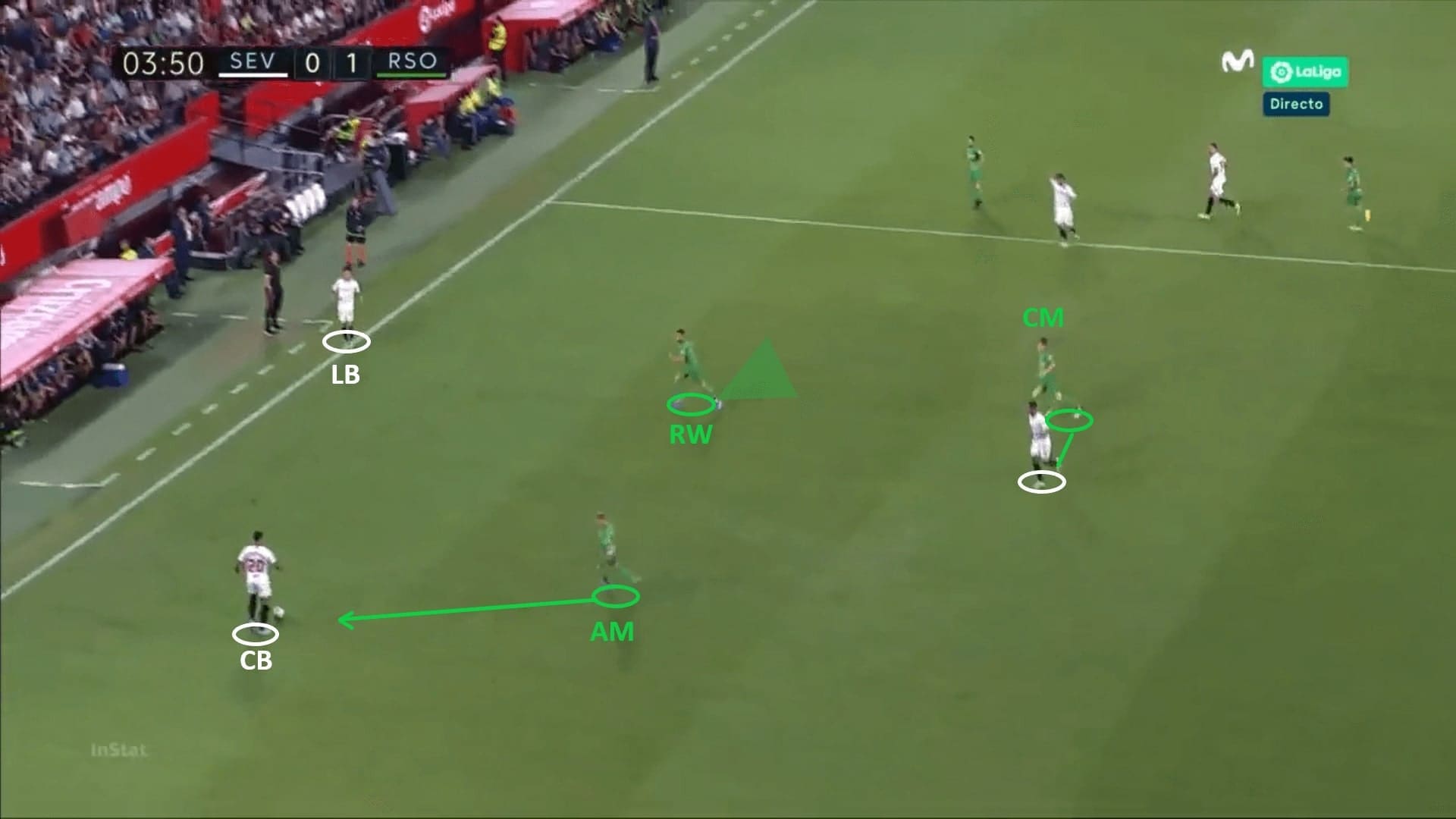
The initial central overload could be converted into a wide overload when the opponents were guided into the trap as explained. After that, the man-oriented midfield could enjoy the freedom to switch into a more zonal approach, overload the wide zone and look to win the ball there.
The example demonstrates this kind of press. The ball was now at the Napoli right-back, who was under the pressure from the left-winger. There were two supportive options, but Sociedad had more as two midfielders were joining. They were the Merino and the pivot, who was tasked to cover spaces.
These players were going to compress spaces and trap the ball within the framed area, which was tight and narrow, hence, a good chance to recover possession. If the opponents were more direct, not falling into the pressing traps, Alguacil’s centre-backs would have to contest for the long balls.
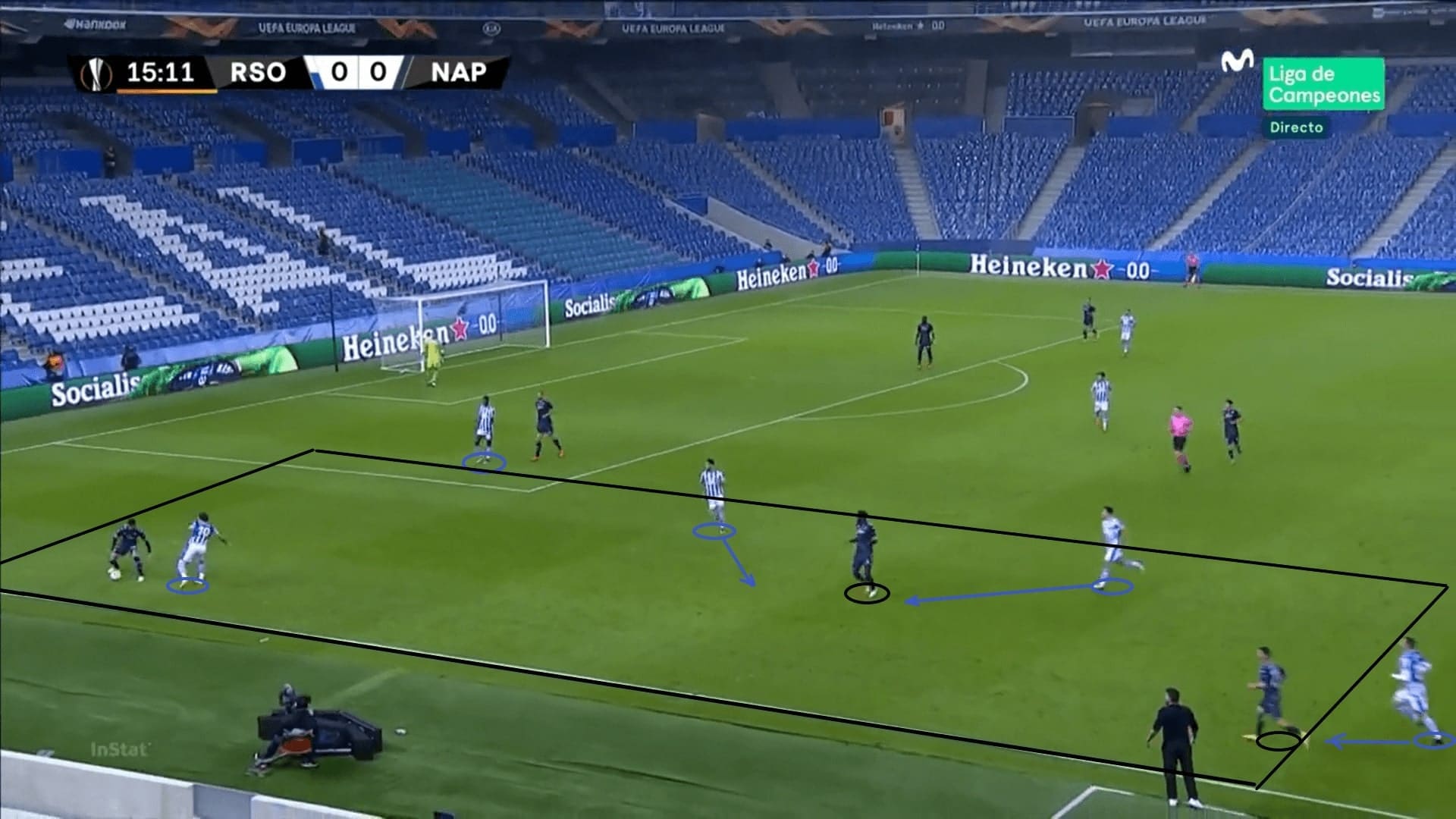
The last section of the analysis explains how Alguacil sets a low block, which is uncommon given the quality of players he has at Sociedad. For example, against Barcelona and Madrid, it was impossible to maintain the same high pressing intensity for 90 minutes. There must be periods to defend deeper in shape, though some concepts are shared.
Alguacil still expects a central overload and a compact defensive shape. In this phase, the players at the second line should step up when the ball is in their vertical zone. However, attacking the ball was not required unless the triggers such as closed body occurred. By staying in shape, Alguacil wanted the opposition to play into flanks, which were the most harmless areas in the defensive third.
In this example, the right midfielder of Sociedad stepped up as the ball entered his zone. This should be able to narrow the passing angle into spaces between the lines, forcing the ball out wide.
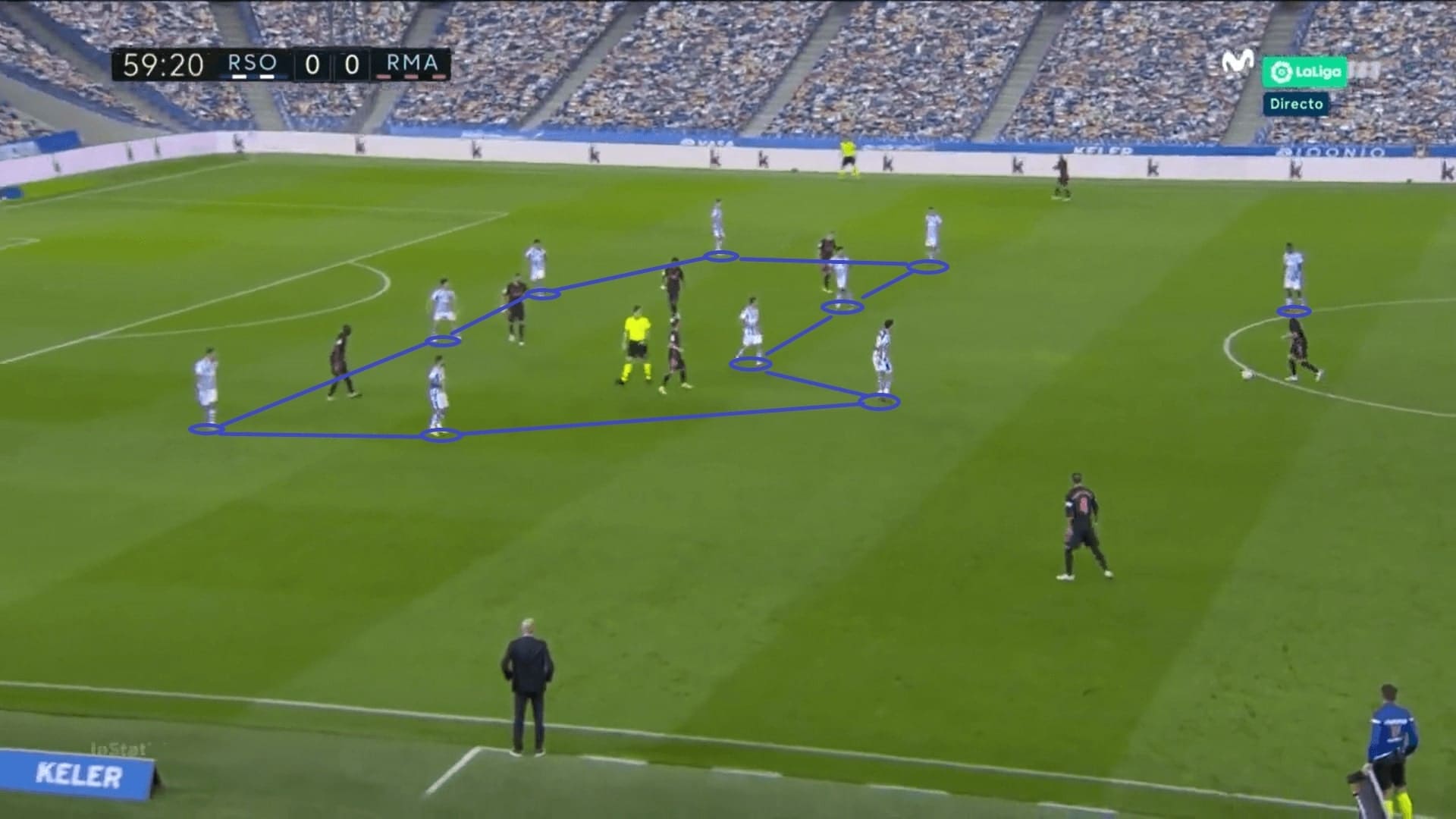
Final remarks
The football of Alguacil requires the confidence of players on the ball, while everyone off the ball should work hard. This a summary of the requirements of players by position. At the moment, Sociedad had the players that suit the expected quality from the head coach. Even Ødegaard returned to Madrid, the arrival of Silva has made an instant impact. Other players such as Oyarzabal and Merino has been improving, the team is even better than the previous campaign.

Alguacil’s philosophy of play is way more than the above analysis, some parts are excluded to keep the focus on the open play principles. The 49-year-old head coach also emphasizes on set-plays, as he believes the performance in this phase would also make the difference. Txuriurdin had many intriguing routes in the dead-ball situations that positively impacted the game as well.
A big 2021 to come! This might be the best chance for Sociedad and ATactilguacil to challenge for the La Liga title. They have quality players with an evenly-distributed age group and talented players. It would also be great to observe how Alguacil would deal with these challenges in the rest of the season.

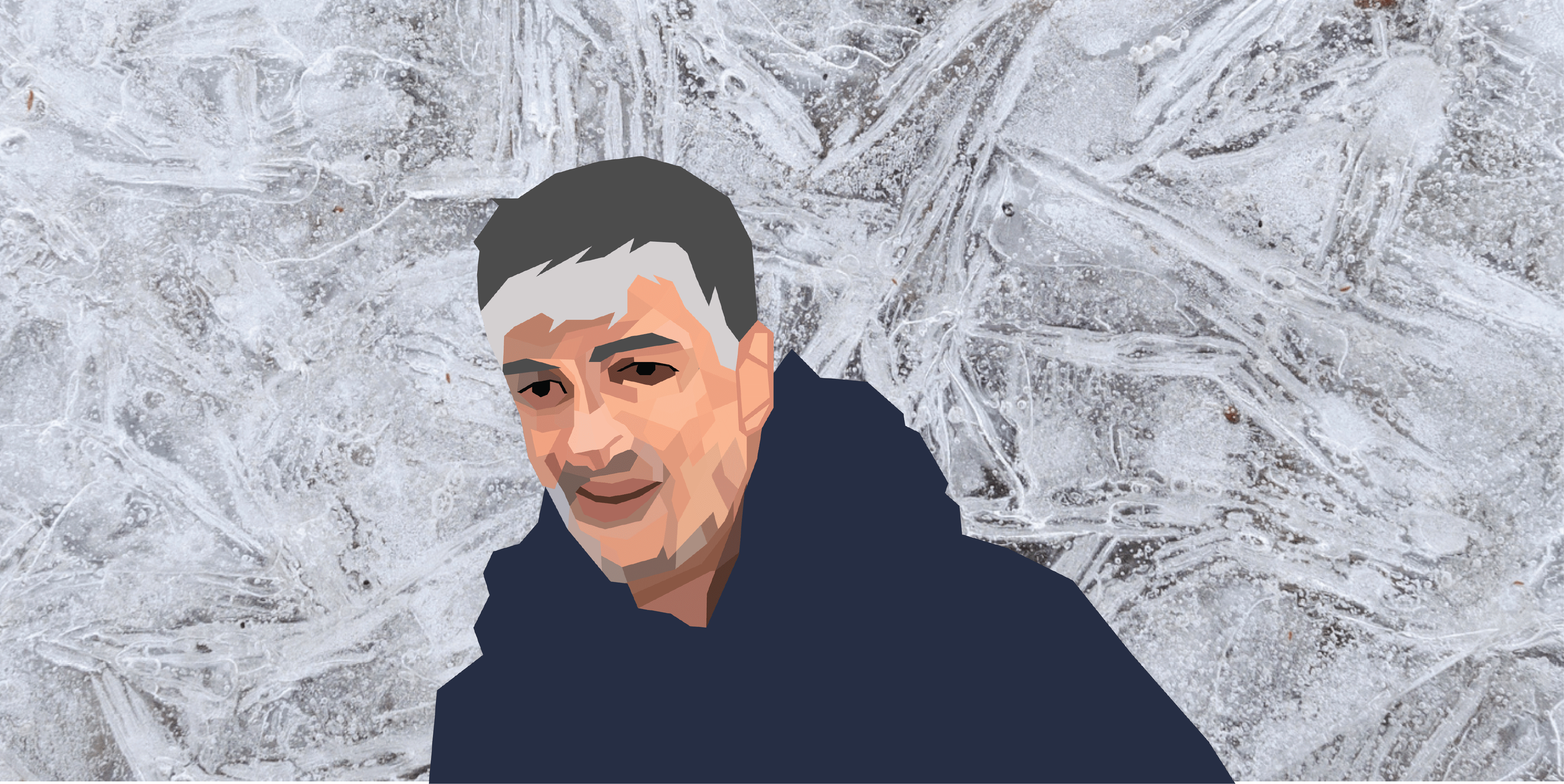


Comments